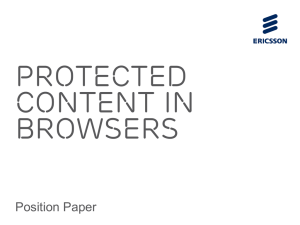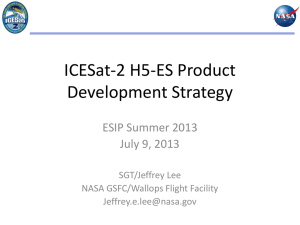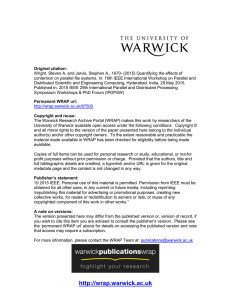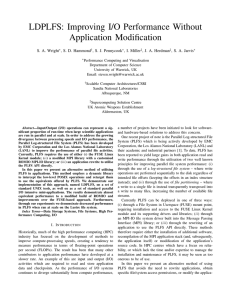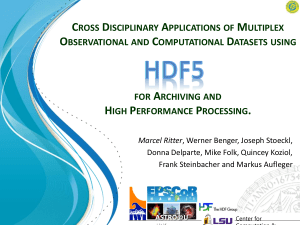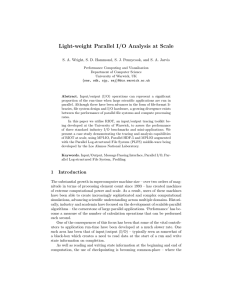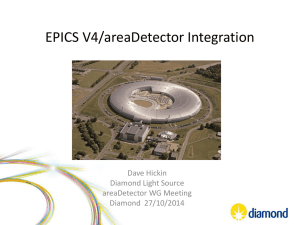slides
advertisement
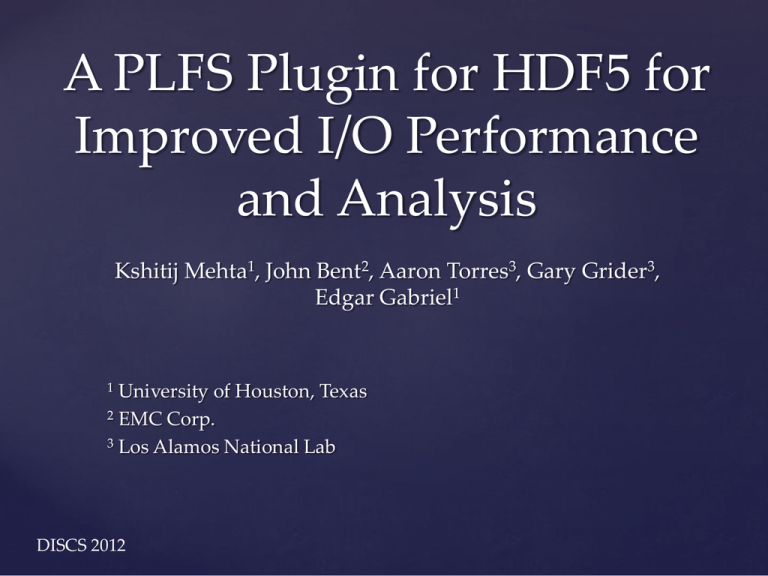
A PLFS Plugin for HDF5 for Improved I/O Performance and Analysis Kshitij Mehta1, John Bent2, Aaron Torres3, Gary Grider3, Edgar Gabriel1 1 University of Houston, Texas 2 EMC Corp. 3 Los Alamos National Lab DISCS 2012 Talk Outline ● ● Background – HDF5 – PLFS Plugin – Goals and Design ● Semantic Analysis ● Experiments and Results ● Conclusion HDF5 – An Overview ● Hierarchical Data Format ● Data model, File format, and API ● Tool for managing complex data ● Widely used in industry and academia ● ● User specifies data objects and logical relationship between them HDF5 maintains data structures, memory management, metadata creation, file I/O HDF5 – An Overview (II) ● ● ● Parallel HDF5 – Build with an MPI library – File create, dataset create, group create etc. are collective calls User can select POSIX I/O, or parallel I/O using MPI-IO (individual/collective) File portable between access by sequential, PHDF5 HDF5 – An Overview (III) File PEs Group Group .h5 file Metadata D1 D2 D3 D1 D2 D3 HDF5 – An Overview (IV) ● File is a top level object, collection of objects ● Dataset is a multi-dimensional array – Dataspace ● ● – Number of dimensions Size of each dimension Datatype ● ● Native (int, float, etc.) Compound (~struct) ● Group is a collection of objects (groups, datasets, attributes) ● Attributes used to annotate user data ● Hyperslab selection – Specify offset, stride in the dataspace – e.g. write selected hyperslab from matrix in memory to selected hyperslab in dataset in file HDF5 Virtual Object Layer (VOL) ● ● ● ● ● Public API Recently introduced by the HDF group New abstraction layer, intercepts API calls Forwards calls to object plugin Object Plugin Allows third party plugin development Data can be stored in any format – netCDF, HDF4 etc. netCDF .h5 Opportunities in HDF5 • Preserve semantic information about HDF5 objects • Single .h5 file a black box • Allows performing post-processing on individual HDF5 objects • Improve I/O performance on certain file systems • N-1 access often results in sub-optimal I/O performance on file systems like Lustre PLFS • Parallel Log Structured File System developed at LANL, CMU, EMC • Middleware positioned between application and underlying file system • Transforms N-1 access pattern into N-N • Processes write to separate files, sufficient metadata maintained to re-create the original shared file • Demonstrated benefits on many parallel file systems Goals of the new plugin • Store data in a new format, different from the native single file format • Preserves semantic information • Perform additional analysis and optimizations • Use PLFS to read/write data objects • Tackles performance problem due to N-1 access Plugin Design • Implementation for various object functions • Provide a raw mapping of HDF5 objects to the underlying file system • HDF5 file, groups stored as directories • Datasets as PLFS files • Attributes as PLFS files stored as dataset_name.attr_name • Use PLFS API calls in the plugin • PLFS Xattrs store dataset metadata (datatype, dataspace,..) • Xattrs provide key-value type access PLFS Plugin ● ● Relative path describes relationship between objects User still sees the same API File File/ Group Group/ D1 Group D2 D1 Group/ D2 D3 D3 Semantic Analysis (I) • Active Analysis • Application can provide a data parser function • PLFS applies function on the streaming data • Function outputs key-value pairs which can be embedded in extensible metadata • e.g. recording the height of the largest wave in ocean data within each physical file • Quick retrieval of the largest wave, since only need to search extensible metadata • Extensible metadata can be stored on burst buffers for faster retrieval Active Analysis (II) FS PE data PLFS Parser Output Parser Burst Buffer Semantic Analysis (II) • Semantic Restructuring • Allows re-organizing data into a new set of PLFS shards • e.g. assume ocean model stored row-wise • Column-wise access expensive • Analysis routine can ask for “column-wise reordering” • PLFS knows what it means, since it knows the structure • Avoids application having to restructure data by calculating a huge list of logical offsets Semantic Restructuring (II) HDF5 Datasets Restructure “Re-order wave lengths recorded in October 2012 in column-major (Hour x Day)” Experiments and Results ● Lustre FS, 12 OSTs, 1M stripe size ● HDF5 performance tool “h5perf” ● Multiple processes write data to multiple datasets in a file ● Bandwidth values presented are average of 3 runs ● 1,2,4,8,32,64 PEs – ● ● ● 4 PEs/node max 10 datasets, minimum total data size 64G Comparing MPI-IO Lustre, Plugin, AD_PLFS (PLFS MPI-IO driver) Individual I/O (non-collective) tests Write Contiguous • Aligned transfer size of 1M • For almost all cases, plugin better than MPI-IO , AD_PLFS shows best performance Write Interleaved • Unaligned transfer size of (1M + 10 bytes) • Plugin performance > MPI-IO Read Performance • Contiguous reads ( 1M ) and Interleaved reads ( 1M+10 bytes ) • Similar trend as in writes • MPI-IO < Plugin < AD_PLFS Conclusion ● ● ● ● ● New plugin for HDF5 developed using PLFS API New output format allows for Semantic Analysis Using PLFS improves I/O performance Tests show plugin performs better than MPI-IO in most cases, AD_PLFS shows best performance Future Work: Use AD_PLFS API calls in the plugin instead of native PLFS API calls, provide collective I/O in the plugin Thank You Acknowledgements: • Quincey Koziol, Mohamad Chaarawi – HDF group • University of Dresden for access to Lustre FS Questions • Why not use AD_PLFS on default .h5 file ? • Changing output format allows for semantic analysis • Provides a more object-based storage (DOE fast forward proposal – EMC, Intel, HDF working towards an object stack)
